(Not exactly) Bike sharing as "Critical Mass," bikelash and changing mobility paradigms: some lessons from Salt Lake City
---------
This and the previous entries touching on Salt Lake City, as well as some future entries, are made possible in part by the Streetsblog Network and OpenPlans, which sponsored the attendance of a number of bloggers, including me, at the recent Congress for the New Urbanism annual meeting in Salt Lake City. That support is gratefully acknowledged.
---------
Left: a tour at the Congress for New Urbanism annual meeting in Salt Lake City was done on the new GREENbike bicycle sharing bikes.
In biking, "Critical Mass" is an anarcho-oppositional technique of taking over the roads by bicyclists, to communicate the need for better sharing road space.
It's more of what planner theorist John Friedmann would call "revolutionary" practice, because it is an in your face challenge to the law and practices of the state and the body politic.
I haven't yet read (it's in my queue) Zach Furness' One Less Car, which covers how much of the bicyclist psyche and bicycle "culture" is tied up in wanting and needing to be the other. From the book's webpage:
Presenting an underground subculture of bike enthusiasts who aggressively resist car culture, Furness maps out the cultural trajectories between mobility, technology, urban space and everyday life. He connects bicycling to radical politics, public demonstrations, alternative media production (e.g., ‘zines), as well as to the development of community programs throughout the world.
One Less Car also positions the bicycle as an object with which to analyze and critique some of the dominant cultural and political formations in the U.S.—and even breaks down barriers of race, class and gender privilege that are interconnected to mobility. For Furness, bicycling can be a form of liberation and a way to support social and environmental justice. So, he asks, Why aren't more Americans adopting bikes for their transportation needs?
I had been meaning to write about the bikelash against the introduction of bicycle sharing in New York City, which I do think with some experience with the system, will decline over time. I find it a bit ironic, because the NYC Department of Transportation had an unbelievably thorough community outreach site selection program.
But at the same time, they should have expected opposition because of the already expressed opposition to other bike-related programming in the city, such as the failed lawsuit against the creation of a cycletrack on Prospect Park West in Brooklyn.
The process of social change: Silly; Controversial; Progressive; Obvious
NotionsCapital pointed me to the article by Tom Vanderbilt, "Silly, Controversial, Progressive, Then Obvious," author of Traffic: Why We Drive the Way We Do (and What It Says About Us), in his How We Drive blog, about the bikelash (I first saw this term in a New York Magazine article, "Not Quite Copenhagen: Is New York too New York for bicycle lanes") on NYC bike sharing. (The otherwise very good John Hilkevitch, transportation writer for the Chicago Tribune, wrote a bad article about bike sharing, "Overtime fees, legal potholes dot city bike-share program.")
Vanderbilt thinks the bike sharing bikelash is a good thing because it indicates a greater acceptance for biking than the opposition seemingly indicates--that people aren't complaining about bike sharing so much as they are the location of specific stations ("City removes a bike share rack after residents sue," NY Daily News).
Although interestingly, the New York Post is full of articles about how bad bike sharing is and will be, while the New York Daily News has been supportive. (But Atlantic Cities says that now the tabloids are cool, since they've had the opportunity to use the bike sharing system. See "New York Tabloids Learn to Love Bike-Sharing After Learning to Ride Bikes.")
Vanderbilt points us to the writings of Harvard economist Lant Pritchett with regard to the adoption of new ideas.
Pritchett's work isn't much different from similar writings on the adoption of social change, social movements, diffusion of innovation (e.g., the work of Everett Rogers which has influenced me a lot ever since I read some of his work more than 25 years ago), social marketing, scientific theory generation and acceptance (Kuhn's Structure of Scientific Revolutions), etc.
But Pritchett does provide a more graspable and succinct way to think about it: Silly; Controversial; Progressive; Obvious.
... versus Rogers' Innovators: Early Adopters; Late Adopters; Early Majority; Late Majority.
Vanderbilt is more positive about bikelash than I am, although he is probably more right than me.
What I probably would have recommended is starting the program off smaller, in Brooklyn, as a pilot.
Because once people see and use the program--WHICH REQUIRES WAY MORE OUTREACH AND STREET MARKETING THAN ANY BICYCLE SHARING PROGRAM HAS DONE IN NORTH AMERICA THUS FAR--they understand it, and start to use it.
Building incrementally and leading from success can be better than all-in strategies that engender opposition
On the other hand, Vanderbilt is probably more right than I that there is a greater level of acceptance, at least in cities (and especially in Salt Lake City and the other smaller cities like Denver and Minneapolis) that are smaller and less a touchpoint on the conservative-liberal agenda and where the proponents of motordom are pretty confident that they still have the upper hand.
In New York City and DC, where the automobile lobby is equally well organized and active, and feels put upon, especially with regard to speed camera, red light camera, and parking tickets, expansion of biking infrastructure is still more controversial than in places like Salt Lake City where they think biking is cool, and where outdoor experience is part of their identity (and brand) as a city, region, and community.
In Salt Lake City they have banners declaring 2013 the year of the bike and had banners for Bike Month (May). You don't see that in places like DC, New York City, or Chicago.
Salt Lake City offers an example of how to provide a wide variety of bike promotion initiatives in a manner that builds the base of support for social change (in addition to the bike share program)
Cycletrack pilot, Salt Lake City. See "Innovative bike lanes unveiled in downtown Salt Lake City" from the Salt Lake City Deseret News. Because Salt Lake City streets are so wide--for the most part wider than DC streets--they don't run into the same opposition of divvying up what in other cities is scarce street space, by taking away traffic lanes in a significant way.
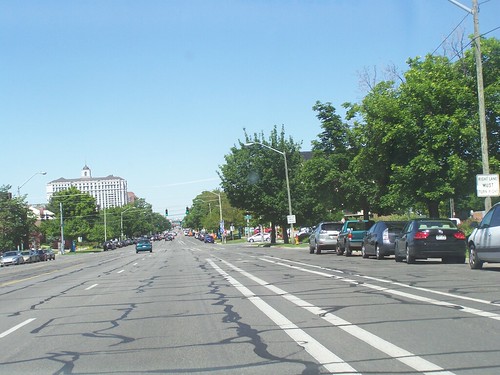
In Salt Lake City, during Bike Month, the transit authority had a bike expo, called the Bike Bonanza. This ad is from the side of a light rail car. They've done this for almost 20 years. See "UTA holds annual Bike Bonanza" from Fox13News. They had two broadcast stories. The videos are online. One thing they do is have a bus there so that people can be educated on how to use the bike racks mounted on the bikes.
This is the same sign on a bus. I talked to the manager of the Bike Transit Center and he said there were about 40 booths, and a fair number of people came out--it was held early evening on a Friday.
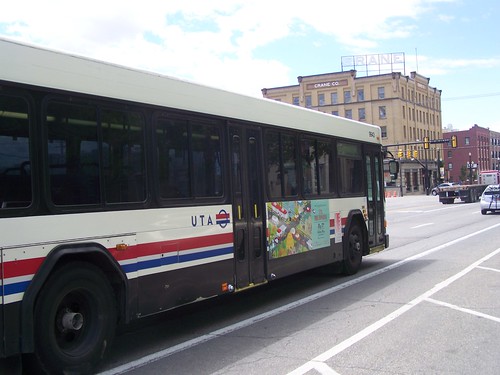
Year of the Bike banner, Salt Lake City
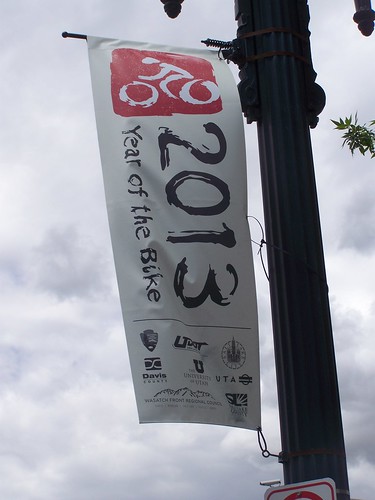
Bike Month banner, Salt Lake City. (Long Beach, California has an extensive banner program promoting biking also.) Salt Lake City also sponsored a successful "Open Streets" program on May 4th. See "Salt Lake City's downtown Open Streets fest a big hit" from the Salt Lake Tribune.
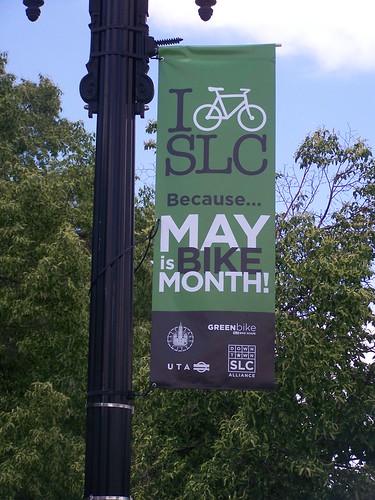
In-city bike tourism. Bike tourism is common in rural areas. It's not marketed so well in cities, although generally most big cities have a variety of bike rental options, some of which are marketed better than others (like in San Francisco). But typically visitor centers and urban tourism efforts under-address biking. Not Salt Lake City.
One of the things that SLC has done is created an on-street bike touring loop that takes about one-half day, covers about 15 miles, and goes to various places, historic sites, commercial districts, etc., around the city. They call it "Cycle the City" and they have a dedicated brochure, map, and signage to support it. It's a good example of both (1) how I say we need to use bikeway signage as a branding and marketing tool and (2) how center cities can do a better job of promoting in-city bike-related tourism.

For Bike Month, the Salt Lake City Central Library did a display of bike-related books. I was shocked to see that they already have City Cycling in their collection. The book was published last fall.
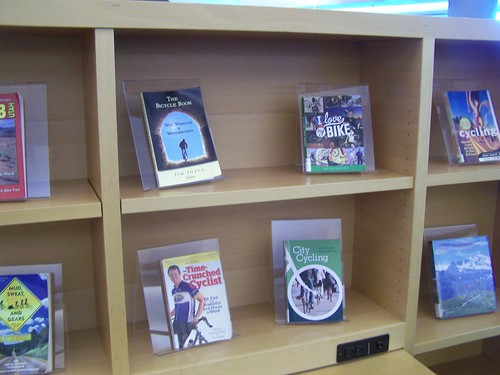
With regard to the implementation of bike share (GREENbike), the program in SLC has done two very interesting things. They got a "bike helmet" sponsor (Intermountain LDS Health System)--they pay for the cost of a high grade helmet which is given to members upon joining. The helmet is easily worth the cost of the membership.

And one of the local bike shops, Salt Lake Bicycle Company, doesn't see the program as competition. They have a display in their window promoting the GREENbike bicycle sharing program. So far, to me, that's unprecedented.
This is a tough question in the industry. There is no question that bike sharing programs can destroy bike rental programs. In a way, I don't have a problem with that, depending on how the program is positioned with regard to transportation demand management. But for members, unless you have bike sharing stations every couple blocks and plenty of capacity, as the system usage increases, it probably becomes a better decision to buy your own bike. (But then the issue of having a greater variety and higher quality of bicycle parking becomes key.)
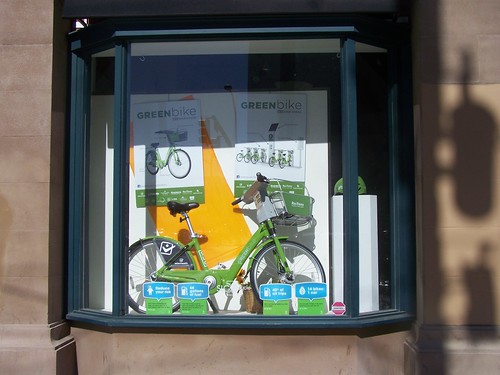
Salt Lake City also has an extensive incentives program, called Bicycle Benefits, for bicyclists, as a way to promote greater take up of bicycling. This poster was posted on the door of a cafe. I saw smaller "we participate" stickers on the windows of other businesses. It costs $5/year to join.
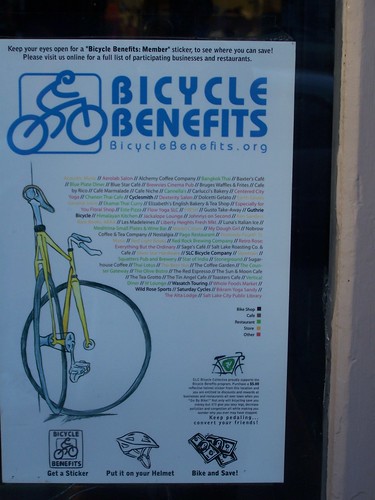
Like a lot of cities, they have a "bike transit center" at the main transit center. And while these programs are visible, they actually don't have a great impact because there isn't a whole lot of demand for use. On the other hand, people don't know that they exist.
While the Bicycle Transit Center gets subsidized rent, provides member-only bike parking, and access to a restroom and shower, they are under-subscribed. The guy who runs the center makes the point that as part of creating such programs, the transit agencies that sponsor them should also commit to promoting the program in a variety of ways, including marketing materials on the commuter trains, etc. Typically it's not done. It's not done in Salt Lake City. Hence, it's under-subscribed, not that they could make much money off it, even were it fully subscribed...
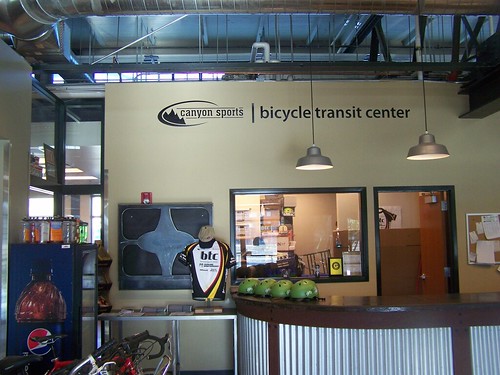
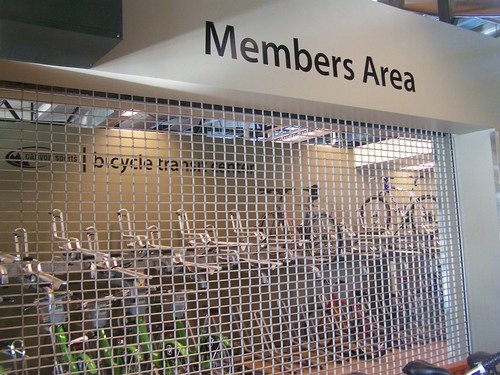
But I haven't seen the ones in the San Francisco Bay Area, done in association with BART. They are supposed to be pretty good. I've seen them in DC, Salt Lake City, Chicago, Indianapolis (super well done), and Long Beach, California.
Interior bicycle parking, Harmon's City Creek Supermarket, Salt Lake City. They have parking outside too. I didn't check the parking structure. But I have never seen interior bike parking provided in this manner within a store. Note that it's not ideal, as you have to lift your bike up and put it on the hook. As you get older, that becomes harder. But still, they are not just thinking about it, they are providing better bike accommodations in a systematic and very visible way. (I already mentioned that a bike sharing station is on their property.)
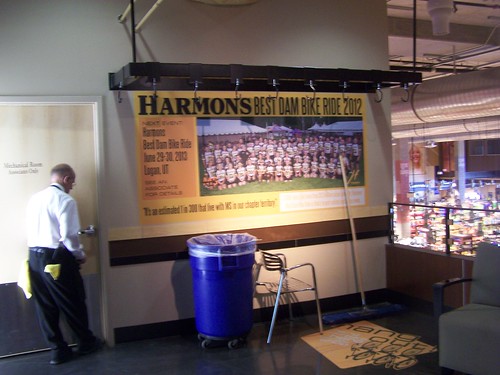
An outdoor bicycle repair stand at the Smith's Supermarket/Gas Station in the Trolley Square neighborhood, Salt Lake City. Smith's is one of the divisions of Kroger, the nation's largest supermarket company. They own a number of convenience store divisions and some of the divisions, like Smith's, have gasoline stations at many of their stores (Smith's Fuel Express). This may be the only location with a bike repair station though. See "Smith's Includes Bike Fix-It Station in New Fuel Center" from Utah Business Journal.
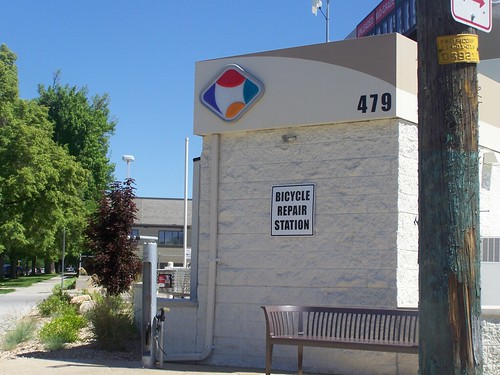
I like that Salt Lake City uses bicycle parking signage ("bicycle parking only") for the in-street bike corrals because it markets bike parking. But they also post the signs to bar motorcycles and scooters from using the parking. (This is an issue in some places in DC, but also indicates that there is a need for more parking for motorcycles and scooters too.)
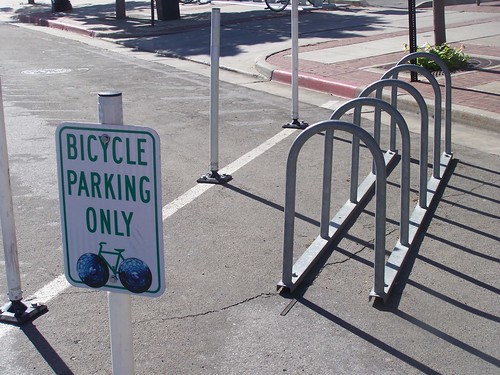
Utah has an annual bike summit. This helps build, strengthen, and extend the community, its representation, and advocacy.
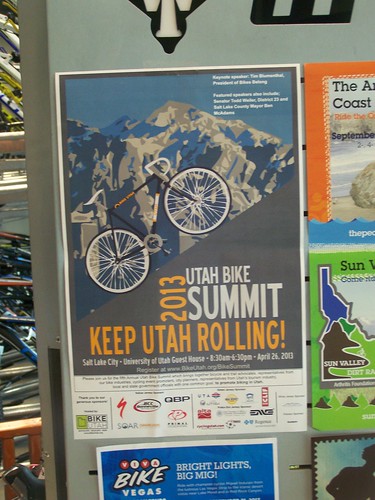
The 2013 State of Utah highway map features a bicyclist on the cover. It's not that they promote biking specifically, but outdoor activities as on the back side of the map it features a skier. Still, it's not a photo of a bunch of cars.
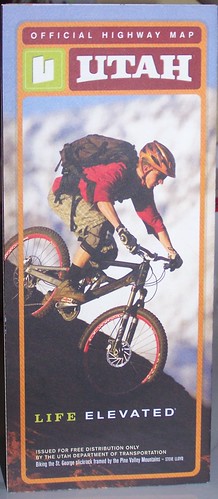
One of the local alternative publications, Slug Magazine featured bicycling for its May issue.

There is a lot of good bicycle parking in Salt Lake City, but some not so good as well. The lesson is to tighten up parking requirements in building regulations and zoning codes. There needs to be much greater specificity. What many jurisdictions think is best practice is not. Of course, this is hardly a problem unique to SLC.

Bicycle rack at the Smith's Supermarket, 876 E 800 South.
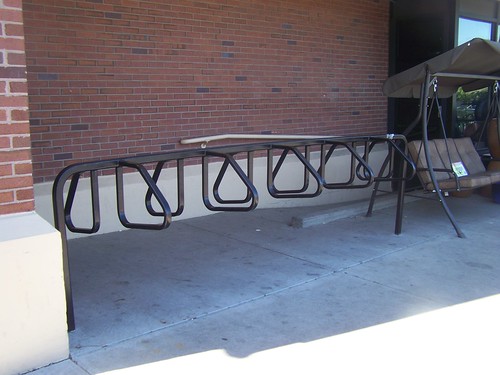
Generally, this type of rack doesn't meet the recommendations for a rack that supports a bicycle frame at two positions. I didn't check the quality of the bike parking provided at the other Smith's Supermarket mentioned above, where they have the great repair station as I was on my way to the Airport.
I am not a fan of this type of bike rack either. (They use it a lot in Chattanooga.) Because it requires that people lift the bike up. This is harder for children and older adults. This rack is located in pretty cool 9th and 9th neighborhood commercial district, Salt Lake City
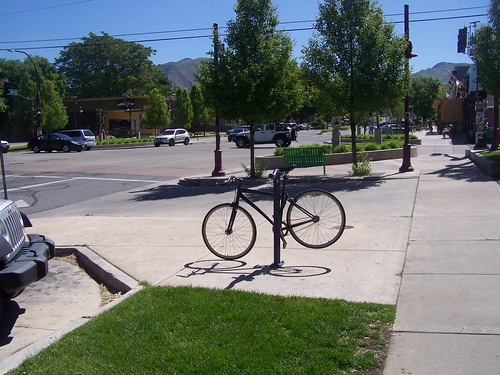
Labels: bicycling, car culture and automobility, sustainable transportation, transportation planning





8 Comments:
certainly a lot of good things going in SLC but still most American bicycle stuff is VC oriented and fosters a VC state of mind in cyclists. The bike racks are emblematic of this- no room for cargo or sit up bicycles which are configured a lot differently than racing or mountain bikes.
1. Because it is biking as transpo.
2. I do have another photo of what you are talking about. I'll have to go back and add it in when I have time. It was near the smith's, a long rack, used by a long bike.
Interesting piece. I haven't been to SLC, but I know from reading SSC they have a very impressive transit build out going on (and relatively high transit usage). All of which complements all the bicycle infrastructure. The sprawl is also limited by it being in a valley, right?
Yep. As Ian Lockwood said, the best cities are those that are constrained. They are building out transit infrastructure very well, but of course we have high ridership.
They have the growing pains of not having figured out how to add in urban design standards and as transit oriented development is occurring they aren't getting the street-level experience right.
But it does take time. E.g., Wilson Blvd. from Courthouse to Ballston is in its second iteration...
Excellent blog you’ve got here.It’s difficult to find high-quality writing like yours nowadays. I really appreciate individuals like you! Take care!! Please check out my site.
Utah tax attorney
Excellent blog post. I really like the set up you have of your display. It looks very inviting.
I love riding critical mass when I'm in town for the outdoor retailers convention.
Thank you again for your flawless service, and I look forward to working with you in the future.
click it...: https://www.dosepharmacy.com
Post a Comment
<< Home